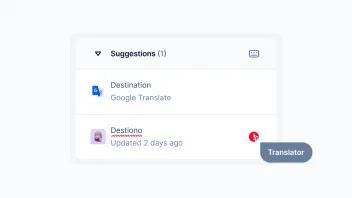Machine Translation Post-Editing: Not Just a Fix, But a Strategy
Here are two statements that are both true: machine translation (MT) is the worst translation method because of its inaccuracies. It’s also one of the most effective translation methods.
How?
MT becomes a powerful tool when paired with human editing, creating the most effective translation approach for businesses—machine translation post-editing (MTPE). Unlike MT or human translation alone, MTPE is both faster and more accurate.
Let’s learn what MTPE is and how to make it work for your company.
What is machine translation post-editing (MTPE)?
Machine translation post-editing, or MTPE, is a human translator's improvement of machine-translated content.
Machine translation (MT) allows businesses to automate and speed up the translation of large volumes of text. Then, professional linguists post-edit machine translation by checking and correcting errors that the MT system may have made, ensuring that the final output is accurate and reads naturally in the target language.
MTPE vs. human translation vs. machine translation
It’s natural to assume that human translation is the most accurate but slow and expensive option, while MT is fast, scalable, and cheap but unreliable. And then there’s MTPE, which sits somewhere in between.
Or does it? Not quite.
As technology evolves, the boundaries between these three methods are becoming more blurred than ever.
Human translation is no longer fully human
According to a 2022 study, around 70% of professional translators now use MT in their work. This means that human translation isn’t necessarily as time-consuming and inefficient as it once was.
MTPE is more than just fixing machine translation
The same study also showed that less than half of translators accept MTPE tasks, and not just because of lower rates. Many find it mentally exhausting, with one respondent even calling post-editing machine translation “soul destroying.”
As machine translation post-editing services become more widespread, post-editors are evolving into a specialized profession. They need native-level fluency, linguistic skills, and expertise in MT systems, common errors, and machine-generated patterns.
Note: There is even an international standard for MTPE – ISO 18587, which outlines the post-editing requirements and expected output quality.
MTPE isn’t just about manual fixing of MT errors anymore. Post-editors can rely on AI tools to spot and fix issues even faster.
That’s not all – MTPE becomes a field of its own, expanding beyond traditional text-based translation:
- Post-editors now refine AI-generated voiceovers to match lip-syncing and tone.
- Some businesses also require real-time MT post-editing, for example, for live content, instant multilingual communication, or customer support.
MT can sound human (sometimes)
MT doesn’t always need post-editing. In some cases, MT delivers fluent, human-like translations with little to no editing needed, especially for simple and general content.
But that’s not always the case. MT can stumble over context and other nuances, including:
- Omission or addition of words and phrases that distort the original message
- Grammar and syntax mistakes
- Misinterpreted negations
- Literal translation, missing context, or cultural differences
- Difficulty handling humor, idioms, slang, and dialects
- Challenges with highly technical or specialized terminology
Note: Not every translation needs to be perfect. In some projects, businesses may choose to overlook these nuances, especially when the content isn’t customer-facing, and the translation speed is the top priority.
The “MT + MTPE” formula isn’t always efficient
For some businesses, machine translation and post-editing may not be the right fit at all.
- 🔒 AI- and NMT-based tools raise privacy and compliance concerns as their responses are often reused to train the model.
- 🚨 AI can hallucinate, inventing facts and generating misleading information – the risk that a business from highly regulated industries can’t take, even with MTPE.
- 🎨 For luxury or highly creative industries, a brand voice can be too nuanced for MT to capture. In that case, human translators are more cost-effective than if post-editors rewrite MT from scratch.
Relevant reading: Translation Technology Guide
With this in mind, are the traditional MTPE types efficient enough for a business? Let’s explore.
Types of machine translation post-editing
Machine translation post-editing is not one-size-fits-all. Depending on the need for quality, context, and the purpose of your text, you might choose between two traditional types: light and full post-editing. Or better create your own, but that’s for later 🤫
Light post-editing (LPE)
When? Quick translation of non-critical documents (for example, internal documentation, chats, emails).
Light machine translation post-editing aims to make the text understandable and accurate with minimum effort. The focus isn’t on style or tone but on clearly conveying the meaning. It’s not publication-ready, but it does the job.
| MT | Light MTPE |
|---|---|
| Weather is agreeable today, good day for walk. | The weather is agreeable today, a good day for a walk. |
In this example, light post-editing includes two key changes: inserting the definite article "The" before "weather" and adding an indefinite article "a" before "walk.” These adjustments ensure a grammatically correct yet simple sentence without overhauling the machine’s work.
Type 2: Full post-editing (FPE)
When? Customer-facing content, marketing, or anything that needs to sound natural.
Full post-editing, on the other hand, is a complete transformation that makes the translation flow naturally and read as a native speaker wrote it. This means fixing grammatical errors, improving style and tone, and even making cultural adjustments.
| MT | Full MTPE |
|---|---|
| Weather is agreeable today, good day for walk. | It’s a delightful day; perfect for a stroll. |
In this full post-editing example, the changes are more comprehensive. The edited phrase now sounds like something you'd actually say.
Beyond light and full PE: focus on what matters
Many businesses turn to MT post-editing as a “good enough” solution to save time, cut costs, or both. However, research shows that post-editors tend to overedit, making changes that don’t fix actual MT errors. Believe it or not, up to 34% of edits could be unnecessary, driven by a translator’s instinct to refine every linguistic detail.
While this level of perfection is great for human translation, it’s often not what MTPE is intended for. And this approach will definitely not save you money on translation.
The primary goal of MTPE is to ensure translation accuracy and consistency with brand guidelines and glossaries, not to rewrite everything from scratch. But with light and full post-editing, you can’t clearly define these priorities to a post-editor.
So, instead of simply asking for a light or full PE, try this two-step approach suggested by Celia Rico Pérez, a professor at the Complutense University of Madrid.
Step 1. Check. Create a checklist for a post-editor to ensure that the MT meets the minimum quality standards. This can include:
- Grammar and spelling rules
- All sentences are translated
- Translation doesn’t contradict the original text
- Terms follow brand glossaries and style guides
Relevant reading: Terminology Management Guide
Step 2. Correct. If you want to post-edit machine translation more thoroughly, add the second step where a post-editor needs to make essential corrections, such as:
- Fixing meaningless or confusing sentences
- Adjusting character formatting
- Improving stylistic flow when it impacts readability, etc.
💡 Pro Tip: Set clear boundaries. Ask post-editors to edit only when it takes less time than translating from scratch.
How to use MTPE effectively: a step-by-step workflow
1. Define your project goals and priorities
Every translation project is unique, with its own demands and challenges. Your budget, timeline, content type, and quality expectations will largely determine the machine translation and post-editing requirements.
Ask yourself 👇
- Are you translating a technical manual or a novel?
- Is the target audience teenagers or business professionals?
- What languages are involved?
- What level of accuracy and style do you need?
- How fast do you expect results?
Example: If you’re translating internal emails, you can rely on MT with zero editing. However, for a humorous social media campaign, you need to significantly post-edit machine translation to preserve creativity and tone.
2. Improve MT outcome before editing
Better input = better output. Investing in a high-quality MT setup can save you time, cost, and countless headaches down the road.
Here are a few practical tips on how to boost MT quality:
- Choose MT tools that support brand glossaries and translation memories.
- Standardize your content: format text properly, avoid slang, idioms, and humor, and use clear non-numeric formats (for example, “August 1” instead of “01/08”).
- Establish and maintain glossaries, style guides, and translation memories.
- Use evaluation metrics like Translation Edit Rate (TER) or BERTScore to measure MT performance.
- Consider using AI to pre-edit MT output before professional post-editors step in.
Relevant reading: ChatGPT Translation Guide
3. Set clear editorial guidelines
Creating a glossary and a style guide (do you want a debate over spaces around an em dash?) gives your editors a clear roadmap, helping them maintain consistency and stick to your brand’s voice. The more detailed and well-structured these guides are, the better translation you may expect.
Example: An e-commerce platform might have a glossary that includes product category names, common technical terms, and promotional phrases. The style guide might specify the tone and style preferences (such as “engaging and persuasive, following AP style”).
However, brand guidelines alone aren’t enough. You must also establish specific instructions for machine translation post-editing service providers, individually for each project.
What to keep in mind 👇
- Be clear on priorities to prevent post-editors from making unnecessary edits.
- Highlight typical MT errors to help post-editors recognize and correct common mistakes.
💡 Pro Tip: Create three instruction sets:
- Brand-specific instructions with style and terminology guidelines
- General post-editing instructions
- Language-specific instructions and preferences
Follow the two-step PE approach I outlined above 👆. Identify the most critical areas for the Checking step (fact-checking, grammar, accuracy, glossary compliance, etc.) and set clear boundaries for the Correcting step.
4. Review, provide feedback, and improve
MT technology is always evolving – and your MT post-editing process should, too.
- Establish a feedback loop with your editors to identify issues and areas for improvement.
- Identify error patterns and adjust your MT settings.
- Regularly review the performance and adjust your approach accordingly. This might mean providing additional training for your editors or tweaking your post-editing guidelines to address common issues.
Example: If editors often flag that the machine translation system struggles with certain idioms, it might be time to adjust the system's settings or provide more training data to improve its performance.
Choosing the right machine translation post-editing services for your business
Many professional translators and linguists offer MTPE services, but not all post-editors are equally good for your project. So how do you choose the best one?
- Native speaker and MTPE expertise. By now, you probably don’t see post-editing as a “simpler job for translators.” It requires specialized skills and can be even more mentally demanding than traditional translation.
- Industry knowledge. If you’re working with technical or specialized content, choose post-editors familiar with your niche.
- Understanding of MT technology. Skilled post-editors do more than fix errors. They understand how MT works and can help you optimize the workflow accordingly.
Example: Skilled post-editors don't waste time manually correcting the same mistranslation over and over. Instead, they add it to a glossary or translation memory, ensuring future consistency and saving time in the long run.
What are machine translation post-editing rates?
Light PE typically costs around 50% of the full per-word translation rate. For more thorough PE, you’ll need to pay around 60-70% of the full rate. Some post-editors also offer project management services to streamline the MT+MTPE workflow, which can increase the final cost.
But here’s the thing: no matter how skilled or expensive your post-editors are, they can’t fix a broken process. The formula for success isn’t just about hiring the best specialists – it’s about optimizing the entire workflow:
- High-quality MT output (because bad MT makes post-editing a nightmare)
- Detailed brand guidelines to ensure consistency
- Well-maintained translation memories to recycle high-quality translations
- Automated post-editing tools to handle repetitive tasks
- Human MTPE expertise for the final polish
- Quality control checks to catch any remaining errors
Sounds complex? It can be unless you have an all-in-one solution like Centus that covers all you need in one centralized platform:
- ⚙️ Multiple MT engines to choose the best for your niche (or use ChatGPT for translation – Centus supports that, too)
- 🛠 Automated quality assurance to catch and fix common MT errors before you post-edit machine translation.
- 📑 Format guides to apply consistent formatting automatically, reducing manual work.
- 📖 Custom glossaries to maintain and enforce preferred terminology.
- 💾 Translation memories you can upload, maintain, or build from scratch.
- 🤖 AI-assisted post-editing to automate and speed up the process.
- 🤝 A unified platform designed for seamless collaboration among post-editors and project managers.
Want to know more about how all this works in one solution? Read our ‘show, don’t tell’ guide on translation management systems.
Or better yet, try Centus yourself. It’s free.
Get the week's best content!
By subscribing, you are agreeing to have your personal information managed in accordance with the terms of Centus Privacy Policy ->
Keep learning

8 min. read
Key Localization Challenges and Solutions in 2025

5 min. read
Localization Quality Assurance: Your In-Depth Guide

12 min. read
Manual and Automated Localization Testing Explained
18 min. read
7 Localization File Formats Explained with Examples

9 min. read